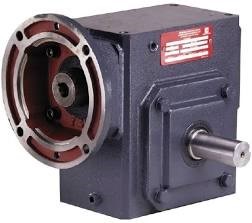Self-locking of a Worm Gearbox
Posted on Tuesday Jun 09, 2020 at 10:29PM in Mechanical
.jpg)
Self-Locking Of A Worm Gearbox
Article By: Joe Hardwick
Business Unit Manager
Self-Locking is the inability of a gearbox to be driven backward by it’s load. In other words, a self-locking gearbox cannot be driven from the output shaft, either through a source of power or an external torque load.
The ability for a gearbox to lock is related to its efficiency. The higher the efficiency, the less likely it is to lock. Because wormgear reducers are generally less efficient than other gear types, they are often considered for use in applications where locking is desirable.
A rule of thumb is that the higher the ratio, the more apt it is to lock. There are too many factors that play into a reducers ability to self-lock for that rule of thumb to be considered effective. Things that influence the gearset locking include ratio, lubrication used, amount of load, service time, input speed, altitude and many others.
When it comes to utilizing a gearbox as a holding or braking device, there is more gray area than black and white. Application concerns have been witnessed where a reducer with a ratio of 60:1 or80:1 single reduction reducers that where utilized in lifting applications without a brake. After several load cycles, the load can start to creep backwards.
Because of the uncertainties with locking gear sets: NO GEARBOX SHOULD BE CONSIDERED TO BE SELF LOCKING. If a load needs to be stopped or held, use a suitable sized brake device.
A rule of thumb is that the higher the ratio, the more apt it is to lock. There are too many factors that play into a reducers ability to self-lock for that rule of thumb to be considered effective. Things that influence the gearset locking


